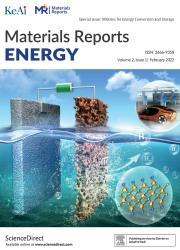Interfacial regulation induced rate capability and cycling stability of poly(perylene diimide) organic electrode
IF 13.8
引用次数: 0
Abstract
Organic electrodes are considered competitive candidates for the next-generation high-performance energy storage devices owing to their advantages of structural flexibility and abundant resources. However, solubility and low electronic conductivity have been major obstacles to the practical application. To address these challenges, the structural design and interfacial regulation of organic electrodes are crucial to the performance enhancement. Herein, we report on a π-conjugated polymer cathode material of poly(3,4,9,10-perylenetetracarboxylic diimide) (PPI) for metal ion batteries, and the performance optimization is achieved by matching suitable conductive carbons and liquid electrolytes. Ultimately, the carbon nanotubes (CNTs) with weight content of 25% and 1 M NaPF6 in ethylene carbonate/diethyl carbonate electrolyte are introduced to assemble the batteries, and the discharge specific capacity, cycling stability and rate performance are enhanced effectively. The PPI-CNT||Na battery displays high specific capacities of 146.4 and 117 mAh g−1 at current densities of 0.1 C and 5 C, respectively. Furthermore, PPI-CNT||Na battery demonstrates excellent long-term cycling stability of 5000 cycles with low 0.007 mAh g−1 capacity decay per cycle at 1C due to the thin and uniform cathode electrolyte interphase. Moreover, the PPI-CNT||Na battery presents good cycling stability at high temperatures of 60 °C, and retains a capacity of 132.5 mAh g−1 after 300 cycles with a high capacity retention rate of 96.9%. Besides, PPI-CNT displays good electrochemical performance and compatibility in lithium-ion and potassium-ion batteries. This work provides an alternative optimization strategy for organic electrodes applied in long-lifetime metal ion batteries.

聚苝酰亚胺有机电极的界面调控诱导速率性能和循环稳定性
有机电极由于其结构灵活、资源丰富等优点,被认为是下一代高性能储能器件的有力竞争者。然而,溶解度和低电子导电性一直是实际应用的主要障碍。为了解决这些问题,有机电极的结构设计和界面调节是提高性能的关键。本文报道了一种用于金属离子电池的π共轭聚合物正极材料聚(3,4,9,10-苝四羧基二亚胺)(PPI),并通过匹配合适的导电碳和液体电解质实现了性能优化。最终,将重量含量为25%的碳纳米管(CNTs)和1 M的NaPF6引入到碳酸乙酯/碳酸二乙酯电解质中组装电池,有效提高了电池的放电比容量、循环稳定性和倍率性能。PPI-CNT||钠电池在0.1 C和5 C电流密度下分别显示出146.4和117 mAh g−1的高比容量。此外,PPI-CNT||钠电池表现出优异的长期循环稳定性,5000次循环,每循环0.007 mAh g- 1容量衰减,在1C下,由于薄而均匀的阴极电解质界面。此外,PPI-CNT||钠电池在60℃高温下具有良好的循环稳定性,在300次循环后容量保持在132.5 mAh g−1,容量保持率高达96.9%。此外,PPI-CNT在锂离子和钾离子电池中表现出良好的电化学性能和相容性。这项工作为应用于长寿命金属离子电池的有机电极提供了另一种优化策略。
本文章由计算机程序翻译,如有差异,请以英文原文为准。
求助全文
约1分钟内获得全文
求助全文
来源期刊

材料导报:能源(英文)
Renewable Energy, Sustainability and the Environment, Nanotechnology
CiteScore
13.00
自引率
0.00%
发文量
0
审稿时长
50 days
 求助内容:
求助内容: 应助结果提醒方式:
应助结果提醒方式:


